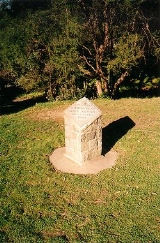
Nelson Battalion of Militia
Encyclopedia
The Nelson Battalion of Militia was formed 12 August 1845 under the terms of the Militia Act of 1845.
This made the Nelson Battalion of Militia the first Army unit to be formed in the South Island
and indeed one of the first in New Zealand. The 2nd Battalion (Canterbury and Nelson-Marlborough, and West Coast), Royal New Zealand Infantry Regiment
celebrates 12 August 1845 as the beginning of its preceding units.
The battalion was commanded by a Commandant, Captain Donald Sinclair, who was also the Nelson Magistrate and was organised into two companies, each of 50 men.
The appointment of the Commandant and other officers was gazetted on 28 August 1845 as being:
The Militia Act of 1845, enabled the Governor to form local Militia units in districts that were under threat of hostile actions or emergencies. All males between the ages of 18 and 60, excepting judges, members of the Legislative Council, Māori and clergymen were expected to make themselves available for 28 days service every year. These Militia units were only permitted to operate within 25 mile radius of the settlement, and were consequently used mainly for garrison duties.
Uniforms were a blue shirt of sailor type pattern, a cap and trousers of any type. Whilst armaments were old flintlock muskets - weapons that had originally been imported for bartering with the Māori.
It is believed that the Nelson Militia had fifes and drums to provide them with musical support.
The battalion paraded and trained three times a day for the first 28 days at Fort Arthur in Nelson. By 28 November 1845 the last of the Militiamen had completed their service obligations and the unit was disbanded.
(or Cathedral Hill) by the New Zealand Company
, to provide a safe haven for the settlers of Nelson following the Wairau Massacre and growing aggression from local Māori.
This made the Nelson Battalion of Militia the first Army unit to be formed in the South Island
South Island
The South Island is the larger of the two major islands of New Zealand, the other being the more populous North Island. It is bordered to the north by Cook Strait, to the west by the Tasman Sea, to the south and east by the Pacific Ocean...
and indeed one of the first in New Zealand. The 2nd Battalion (Canterbury and Nelson-Marlborough, and West Coast), Royal New Zealand Infantry Regiment
Royal New Zealand Infantry Regiment
The Royal New Zealand Infantry Regiment is the main combat unit in the regular New Zealand Army. It was formed 9 January 1947 as the New Zealand Regiment with a single infantry battalion as part of the newly created infantry corps....
celebrates 12 August 1845 as the beginning of its preceding units.
The battalion was commanded by a Commandant, Captain Donald Sinclair, who was also the Nelson Magistrate and was organised into two companies, each of 50 men.
The appointment of the Commandant and other officers was gazetted on 28 August 1845 as being:
- Captains: Donald Sinclair, John D. Greenwood, David MonroDavid MonroSir David Monro was a New Zealand politician. He served as Speaker of the New Zealand House of Representatives from 1861 to 1870.-Early life:...
- Lieutenants: Thomas Renwick, Francis Dillion Bell
- Ensigns: Charles Thorpe, Alexander le Grand Campbell
- Quartermaster: Henry Seymour
- Adjutant: Richard Newcombe
The Militia Act of 1845, enabled the Governor to form local Militia units in districts that were under threat of hostile actions or emergencies. All males between the ages of 18 and 60, excepting judges, members of the Legislative Council, Māori and clergymen were expected to make themselves available for 28 days service every year. These Militia units were only permitted to operate within 25 mile radius of the settlement, and were consequently used mainly for garrison duties.
Uniforms were a blue shirt of sailor type pattern, a cap and trousers of any type. Whilst armaments were old flintlock muskets - weapons that had originally been imported for bartering with the Māori.
It is believed that the Nelson Militia had fifes and drums to provide them with musical support.
The battalion paraded and trained three times a day for the first 28 days at Fort Arthur in Nelson. By 28 November 1845 the last of the Militiamen had completed their service obligations and the unit was disbanded.
Fort Arthur
Fort Arthur was an elongated hexagonal earthwork about 445 ft by 259 ft (136 m by 80 m), with bastions at each corner, on the flanks of a hill. Within the earthworks, on high ground, stood a stockade measuring 156 ft by 48 ft (48 m by 15 m). It had been built in September 1843 on the site of what is now Christ Church CathedralChrist Church Cathedral, Nelson
Christ Church Cathedral is an Anglican cathedral in Nelson, New Zealand. The cathedral is located at upper Trafalgar Street.-History:In 1851 the first church was erected at a different site. In 1866 the church was named as Christ Church Cathedral. In 1887 a second church was constructed at the...
(or Cathedral Hill) by the New Zealand Company
New Zealand Company
The New Zealand Company originated in London in 1837 as the New Zealand Association with the aim of promoting the "systematic" colonisation of New Zealand. The association, and later the company, intended to follow the colonising principles of Edward Gibbon Wakefield, who envisaged the creation of...
, to provide a safe haven for the settlers of Nelson following the Wairau Massacre and growing aggression from local Māori.

